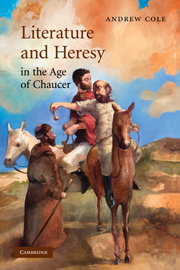Book contents
- Frontmatter
- Contents
- Preface
- Acknowledgments
- List of abbreviations
- PART I THE INVENTION OF HERESY
- PART II THE LATE FOURTEENTH CENTURY: CANONIZING WYCLIFFISM
- 2 The invention of “lollardy”: William Langland
- 3 The reinvention of “lollardy”: William Langland and his contemporaries
- Intermezzo: Wycliffism is not “lollardy”
- 4 Geoffrey Chaucer's Wycliffite text
- PART III THE EARLY FIFTEENTH CENTURY: HERETICS AND EUCHARISTS
- PART IV FEELING WYCLIFFITE
- PART V EPILOGUE
- Notes
- Bibliography
- Index of manuscripts cited
- General index
- CAMBRIDGE STUDIES IN MEDIEVAL LITERATURE
3 - The reinvention of “lollardy”: William Langland and his contemporaries
Published online by Cambridge University Press: 22 September 2009
- Frontmatter
- Contents
- Preface
- Acknowledgments
- List of abbreviations
- PART I THE INVENTION OF HERESY
- PART II THE LATE FOURTEENTH CENTURY: CANONIZING WYCLIFFISM
- 2 The invention of “lollardy”: William Langland
- 3 The reinvention of “lollardy”: William Langland and his contemporaries
- Intermezzo: Wycliffism is not “lollardy”
- 4 Geoffrey Chaucer's Wycliffite text
- PART III THE EARLY FIFTEENTH CENTURY: HERETICS AND EUCHARISTS
- PART IV FEELING WYCLIFFITE
- PART V EPILOGUE
- Notes
- Bibliography
- Index of manuscripts cited
- General index
- CAMBRIDGE STUDIES IN MEDIEVAL LITERATURE
Summary
for the lollards, storm was shelter.
JoyceIn the late fourteenth century, bishops, schoolmen, chroniclers, preachers, and poets of all stripes could agree on one thing: in 1382, the Wycliffites were condemned as heretics by the Blackfriars Council in London and exposed as “lollards.” Yet what they neglect to mention is that nobody actually knew what a “lollard” was in 1382. For the word itself was not yet available and would not be until 1387. There was simply no way yet of capturing, in a word, all that is so politically and theologically troubling about Wycliffism. That particular point of historical accuracy did not matter, however, to those looking back on 1382. For the term so saturated late medieval legal, literary, and chronicle discourse that most witnesses already knew the Wycliffites as “lollards.” The Wycliffites were, of course, not pleased about this “lollardy” – the way in which a dissident identity could be concocted on their behalf, and the ease with which a formidably large body of work and an interestingly persuasive set of ideas could be damned and dismissed in just a single word. And they were not alone in that view.
This chapter explores how “lollardy” was transformed from a curse word to a term of approbation rich in meaning and seeks to illustrate a broader cultural phenomenon I call the “reinvention of lollardy.”
- Type
- Chapter
- Information
- Literature and Heresy in the Age of Chaucer , pp. 46 - 71Publisher: Cambridge University PressPrint publication year: 2008



